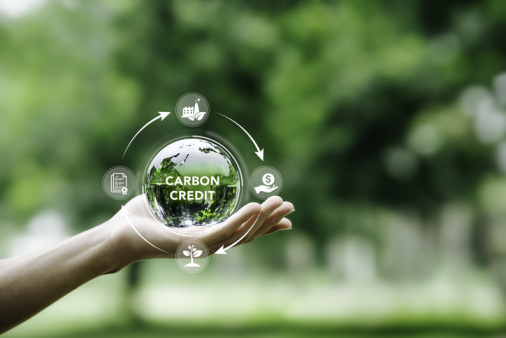Voluntary carbon credits at an inflection point

Authored by HDI
Voluntary carbon markets can help accelerate the shift to net zero – but they must be held to high standards of integrity and transparency. Despite their huge growth prospects, a lack of credible standards is currently limiting their potential. This may be set to change.
This is a crucial time for voluntary carbon markets (VCMs). After several years of rapid growth due to growing pressure on companies to improve sustainability, progress has slowed. Now, demand for carbon credits is set to fall in 2023 – the first dip in at least seven years, according to BloombergNEF.
Global consultancy Bain says VCMs are at an inflection point: either collaboration will resolve the uncertainties and complexities that currently plague the sector, or poor alignment and confusion will continue to slow growth and “limit the potential of this important tool in the fight against the climate crisis”.
Voluntary vs compliance carbon markets
So, where are things going wrong? First, it’s important to highlight the differences between VCMs and government-regulated compliance markets, like the EU’s Emissions Trading System.
Compliance markets are established by national, regional and international regulations. Within these, organisations can buy and sell carbon credits to adhere to carbon reduction targets. The money is then used to fund projects that reduce or remove greenhouse gas emissions, including forestry protection, solar farms and carbon capture schemes. Compliance markets mostly cover hard-to-abate sectors like heavy industry, power generation and aviation. VCMs, on the other hand, follow a similar principle but give options to companies in sectors or regions not covered by compliance markets.
In terms of size, there’s little comparison between the two: compliance markets have an annual trading volume approaching USD 1 trillion, which dwarfs the USD 2 billion traded by VCMs. Nevertheless, one report by Morgan Stanley says VCMs could be a 250-billion dollar sector by 2050.
Lack of standards and guidelines
But if VCMs are to fulfil their potential, the sector needs to change. VCMs aren’t as strictly regulated as compliance markets, and there have been several reports criticising the quality of carbon offset schemes on offer.
Recent analysis by the Guardian newspaper and Corporate Accountability, a transnational corporate watchdog, said more than 75 per cent of the top 50 emission projects available in VCMs don’t meet basic criteria. Carbon credit projects must provide additional, permanent cuts in greenhouse gas emissions, but the study found many projects would have happened anyway, while others exaggerated reductions claims or shifted emissions elsewhere.
A lack of standards and guidelines is making “good” market participation indistinguishable from investment in low-quality projects, says the World Economic Forum. In a 2022 survey it conducted with Bain, around half of corporate respondents cited a complex web of standards, varying definitions of carbon credit quality or a lack of market transparency as the main reasons for not buying voluntary carbon credits. Around 40 per cent cite the risk of reputational damage, including legal action.
More transparency to combat climate change
Two independent international organisations are hoping to bring greater transparency and credibility to VCMs. Both the Voluntary Carbon Markets Integrity Initiative (VCMI) and the Integrity Council for the Voluntary Carbon Market are introducing guidance to help companies identify quality carbon credits that are making a real difference to climate change.
“Voluntary carbon markets bring considerable benefits as part of companies’ net-zero transition and as a means of financing climate transition worldwide,” said VCMI’s Rachel Kyte at the unveiling of its new Claims Code in June 2023. “Against a backdrop of recent criticism, we are now at a juncture where only consistent, well-considered global guidance can underpin a high-quality market and stimulate the rapid scaling of corporate use we need.”
By putting a price on carbon and creating an economic incentive for reducing emissions, as well as generating funds to build resilience, carbon markets can help accelerate the shift to net zero, says the UN. But they must be held to high standards of integrity and transparency.
To help scale meaningful climate action using carbon markets, the World Economic Forum recommends that companies take the following five steps:
- Set a decarbonisation pathway aligned with scientific recommendations to ensure demand-side credibility in the use of carbon credits.
- Acknowledge the urgency of protecting natural carbon sinks and other high-integrity, community-based projects.
- Adopt and scale leading standards and practices critical to improving quality and establishing credibility of corporate credit use.
- Create market transparency through corporate disclosures on climate and nature impact, project types, pricing and transaction costs and flows.
- Amplify corporate commitments to immediate participation at scale through collective action to establish credibility while signalling demand to the market
About HDI Global SE
Companies from the trading, production and service industries need an insurance partner they can rely on.
As part of the Talanx Group, HDI Global SE has been one of the leading insurers offering a broad and needs-based range of insurance solutions and accompanying services for decades.
HDI operates through foreign branches, subsidiaries and affiliates as well as network partners in more than 150 countries, offering international industrial insurance programmes.

